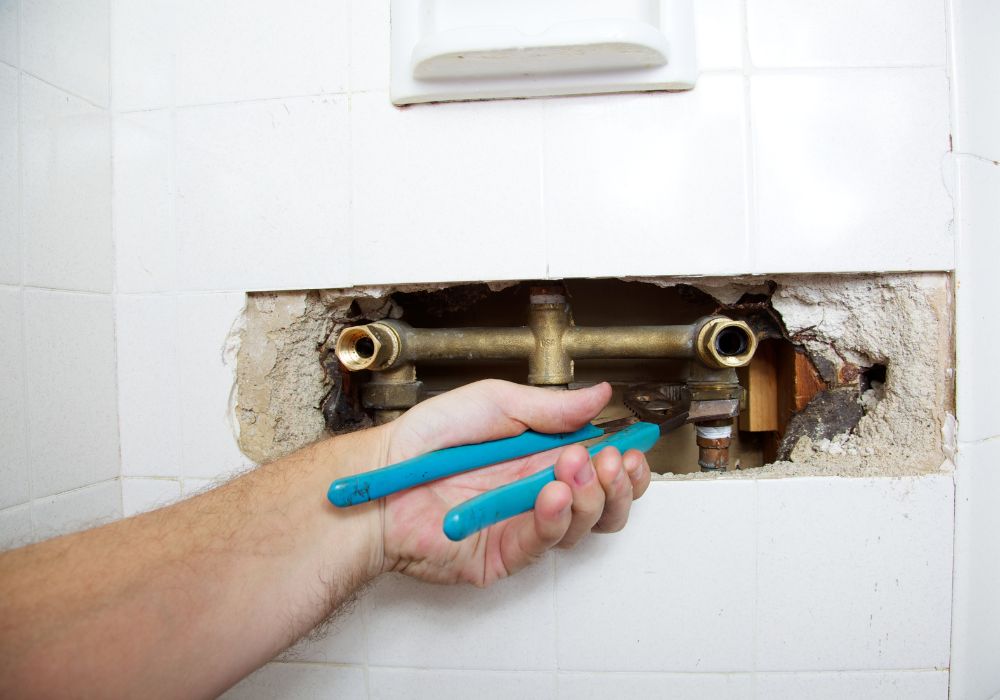Ever encountered a strange bathroom situation that left you scratching your head? Imagine this: you turn on the faucet to fill your relaxing bath.
Instead of water entering the bathtub as usual, it begins to flow out from the rear of the tub spout.
In this blog post, we will uncover the peculiar problem and learn to resolve it. Additionally, we will offer valuable tips on effectively tackling this issue.
At the same time, we aim to provide you with simple steps and guides on restoring a tub spout’s normal operation.
Water coming from the back of the tub spout may be due to infrastructure issues or faulty components. Possible causes include broken pipes, loose connections, or worn-out seat washers.
In most cases, damaged faucet parts like the diverter valve can also lead to leakage. In addition to that, mineral build-up from hard water or an old tub spout could be the culprit.
Why Is Water Coming Out Of The Back Of The Tub Spout?
If water comes out of the back of the tub spout, it is likely due to a serious framework issue. Also, it could be one of several potential problems with the tub spout itself.
Here are some possible causes for water leakage from the back of the tub spout:
Plumbing Infrastructure Issue
In some cases, plumbing infrastructure leading to the tub spout is highly compromised. This could include a broken or damaged pipe.
At the same time, it can lead to loose connections or other issues within the plumbing system.
Faulty Seat Washer
The tub spout is generally connected to the plumbing through a valve stem. This is highly equipped with a seat washer.
If this washer is worn out or damaged, it can leak water from the back of the spout.
Damaged Faucet Parts
The internal components of the tub spout, such as the diverter valve, can become damaged over time.
If these parts are faulty or they may not effectively control the flow of water, leading to leakage.
Mineral build-up
Over time, mineral deposits can accumulate inside the tub spout. As a result, this blocks the water flow and causes leaks.
The mineral build-up is more common in areas with hard water. Descaling the spout can help remove these deposits and restore proper functionality.
Old Tub Spout
When the tub spout becomes old, it can develop cracks and holes. It can also lead to other defects that enable water to escape from the tub spout.
Replacing the old tub spout with a new one is often the most effective solution to address the issue.
Can a Leaking Bathtub Be Repaired?

A leaking bathtub can typically be repaired using different methods. The initial step is to pinpoint the source of the leak.
That can be in the faucet, handles, drain, or surrounding pipes.
Act Fast
Water leaks should never be highly ignored. They can cause further damage to your bathroom.
Thus, it can potentially lead to more extensive repairs. Act promptly to prevent any worsening of the situation.
Identify The Problem
Begin by identifying the source of the leak. Leaks can originate from various areas. These include the faucet, handles, drain, or nearby plumbing connections.
Thoroughly inspect these components to pinpoint the exact location.
Simple Fixes
For minor leaks, simple repairs are often effective. This may involve replacing a worn-out washer within the faucet.
These repairs are easy and can be highly accomplished using basic plumbing tools.
Replace Worn-out parts
Consider replacing the gasket or seal between the bathtub and the drain. This helps ensure a proper seal, preventing water from escaping.
Regular Maintenance
Don’t neglect regular checks to prevent future leaks. Conduct visual inspections periodically. Pay attention to signs of wear, loose connections, or damaged seals.
You can save yourself from more significant repairs by catching issues early on.
Remember, you can fix minor leaks on your own. However, more complex issues may require professional assistance. If the leak persists, it’s wise to contact a qualified plumber.
They have the expertise and knowledge to diagnose the problem accurately. Additionally, they can provide appropriate solutions, ensuring a long-lasting, leak-free bathtub.
How Do I Stop My Tub Spout From Leaking?
You should turn off the water supply to stop the tub spout from leaking. Then remove the retaining screws.
Next, pull out the cartridge, reinstall the spout, and test the water supply.
Step 1: Turn off the water supply
Locate the shut-off valve for your tub or turn off the main water supply to your home. This will prevent water from flowing while you work on the tub spout.
Step 2: Remove the retaining screw
Check underneath the tub spout for a screw. Use a screwdriver, then unscrew the retaining, and keep it in a safe place.
Step 3: Extract the cartridge
Firmly grip the tub spout and pull it directly away from the wall. The spout may be either a slip-on type or threaded, depending on its design.
If it’s threaded, twist it counterclockwise to unscrew and detach it.
Step 4: Reinstall the spout
Inspect the spout thoroughly for any signs of damage or worn-out components. If needed, replace the cartridge or any faulty parts.
To ensure a tight seal, wrap the plumber’s tape around the threads of the spout. Then, firmly push the spout back into the wall until it fits snugly.
Step 5. Turn on the water supply and test
Open the shutoff valve to restore the water supply. Check for any leaks around the spout.
If there are no leaks, test the tub faucet by running the water to ensure it functions correctly.
How Do You Tighten a Tub Spout?
Imagine your tub spout as a loose thread on a garment. To tighten it, you need to follow a few simple steps.
First, locate the secret hiding spot of the set screw, usually lurking beneath or on the side of the tub spout.
Next is to use a trusty screwdriver or an Allen wrench. Loosen and remove the set screw, releasing the tub spout from its shackles.
With a twist-on spout, a simple counterclockwise twist will coax it off the pipe. You may use a pipe wrench or pliers wrapped in a protective shield of cloth or tape.
Now that you’ve taken the old spout, it’s time to find its perfect replacement match. Check measurements and connection types to ensure compatibility. And then install the new faucet spout.
Slide it onto the pipe and twist it clockwise or push it firmly.
Finally, turn on the water supply and put the spout to the test. Look for any signs of leaks and make sure the spout feels secure.
If all is well, you have successfully tightened your tub spout. Additionally, you can enjoy a satisfying bath or shower without worrying about leaks.
Tightening a tub spout requires attention to detail and a systematic approach. You can achieve a tight and reliable connection by locating the set screw and opening the tub spout.
Keep in mind selecting the appropriate replacement, and install it securely. If you encounter challenges, seeking guidance from a professional plumber is wise.
You can repair the simple task of tightening a tub spout with the proper steps and care. Plus, get to enjoy a leak-free bathing experience!









